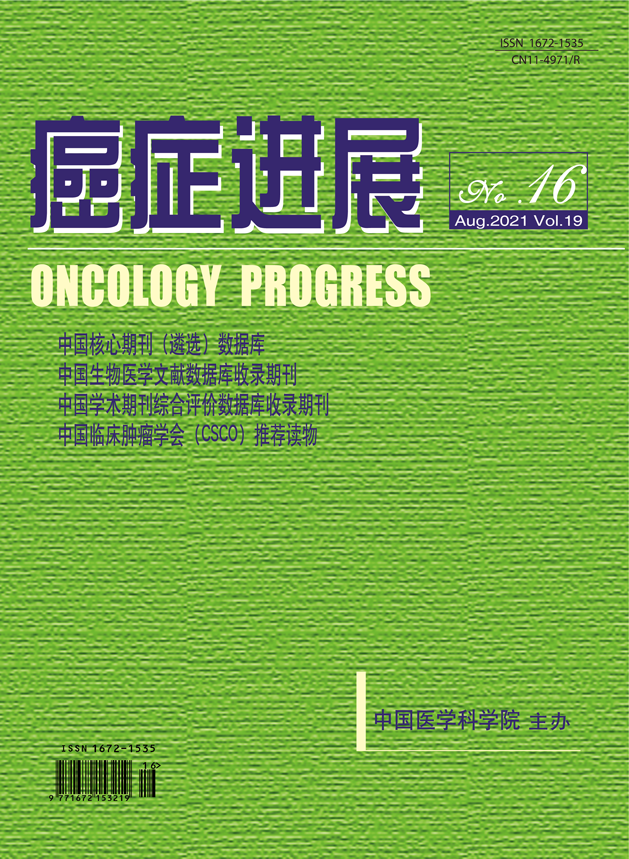杂志信息/Information

- 刊名:癌症进展
- Oncology Progress Journal
- 主管:国家卫生健康委员会
- 主办:中国医学科学院
- 社长:张凌
- 主编:赵平
- 编辑部主任:穆红
- 出版单位:中国协和医科大学出版社有限公司
《癌症进展》编辑部
100730,北京东单三条9号
联系电话:010-57528109
E-mail:azjzzz@163.com
http://www.aizhengjinzhan.com - 印刷:北京联合互通彩色印刷有限公司
- 国内统一连续出版物号:CN 11-4971/R
- 国际标准连续出版物号ISSN 1672-1535
下载专区/Download
订阅电子期刊/Subscribe
提交您的邮箱地址,我们会定期将电子期刊 发送到您的邮箱
期刊检索/Journal Search
扫一扫,关注

2015 年第 3 期 第 13 卷
可根治切除残胃癌的临床病理特征及预后
作者:
单位:
- 摘要:
- 【摘要】目的 分析可根治切除残胃癌临床病理特征及预后情况。方法 回顾分析1999年11月至2013年12月进行残胃癌根治切除术的63例患者的临床病理资料,按照初次手术方式组和初次手术时疾病良恶性分组,分析比较残胃癌临床病理特征以及长期生存率。结果 按照初次手术疾病良、恶性分组,残胃癌发病的间隔时间分别为24.8年、8.9年;肿瘤直径分别为6.9cm、4.3cm;残胃癌位于吻合口的比例分别为50%、26.3%。按照初次手术方式(BillrothⅡ、BillrothⅠ)分组,残胃癌发病的间隔时间分别为22.8年、12.3年。肿瘤直径分别为6.73cm、3.75cm。残胃癌位于吻合口的比例分别为52.4%、21%。以上各组比较P<0.05,差异均有统计学差异。TNMⅠ-Ⅱ期与Ⅲ期患者80个月生存率分别为64.7%:18.5%,P<0.05,差异有统计学意义。初次手术良性组与初次手术恶性组,100个月累计生存率分别为37.1%、40%,差异无统计学意义(P>0.05)。BillrothⅡ组与BillrothⅠ组,患者80个月累计生存率分别为43.1%、27.3%,差异无统计学意义(P>0.05)。结论 初次胃切除术时疾病良恶性、重建方式与残胃癌发病间隔时间、肿瘤大小、肿瘤好发部位等临床特点有关。可根治切除的残胃癌患者,其长期生存率与初次胃切除术时疾病良恶性、重建方式无关,与TNM分期有关。
- Abstract: Objective To evaluate the clinicopathological features and prognosis of gastric stump carcinoma (GSC) following curative surgery. Method The clinicopathological features and long-term survival rate of 63 patients who had underwent curative gastrectomy for gastric stump carcinoma from November 1999 to December 2014 were analyzed retrospectively. Result The GSC following gastrectomy for benign lesions has a longer interval (benign vs malignance: 24.8 vs 8.9 years, P<0.05), has a bigger tumor size (benign vs malignance: 6.9 vs 4.3 cm, P<0.05), and has a higher proportion of GSC located in anastomosis (benign vs malignance: 50% vs 26.3%, P<0.05). The BillrothⅡ reconstruction group has a longer interval (BillrothⅡ vs BillrothⅠ: 22.8 vs 12.3 years, P<0.05), has a bigger tumor size (BillrothⅡ vs BillrothⅠ: 6.73cm vs 3.75cm, P<0.05), and has a a higher proportion of GSC located in anastomosis (BillrothⅡ vs BillrothⅠ: 52.4% vs 21%, P<0.05). The 80-month survival rate of the stage Ⅲ group were significantly higher than the stageⅠ-Ⅱ group (64.7% vs 18.5%, P<0.05).The long-term survival rate had no statistical significance when the patients were grouped according to initial diseases and initial reconstructed methods. Conclusion The patients with GSC had different clinicopathological features according to the initial diseases and the reconstruction methods. For patients with resectable GSC, long-term survival was associated with TNM staging, rather than the initial diseases and the reconstruction methods.








